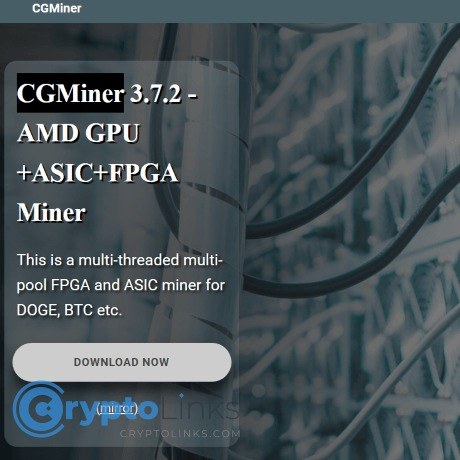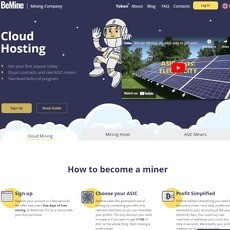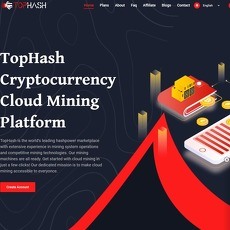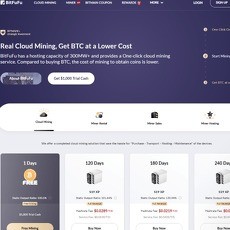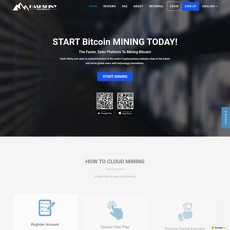CGMiner Review
CGMiner
cgminer.info
CGMiner.info Review: Unlocking Efficient Mining for DOGE, BTC, and More
Ever feel like you're not squeezing every bit of potential from your cryptocurrency mining setup? With so many mining software options out there, each claiming to be the ultimate solution, it's easy to get lost. I've been there—hours spent sifting through forums, testing programs that just didn't cut it. The search for reliable and efficient mining software can be downright exhausting.
The Challenges of Finding Reliable Mining Software
Mining isn't just about stacking up powerful hardware; it's about finding the right software to make that hardware work efficiently. I've encountered a few bumps along the way:
- Scams and Security Risks: Downloaded a miner once that turned out to be malware. Not fun.
- Inefficient Resource Use: Some software just doesn't tap into the full power of my rigs.
- Complex Configurations: Ever tried setting up a miner that requires a degree in rocket science?
These hurdles can slow down your mining efforts and eat into your profits, which is the last thing any of us want.
Introducing CGMiner.info as a Solution
This is where CGMiner.info comes into the picture. It's a multi-threaded, multi-pool FPGA and ASIC miner that's been around the block and earned its stripes. Over the years, it has become a reliable tool for miners looking to optimize their operations across different cryptocurrencies.
Why You Should Consider CGMiner.info
So, what's so special about CGMiner.info? Well, let me break it down:
- Reliability: It's been tested and trusted by the mining community for years.
- Efficiency: Designed to make the most out of your hardware's capabilities.
- Flexibility: Supports multiple cryptocurrencies, so you can switch things up as needed.
In this review, I'll dive into the features that make CGMiner.info stand out and how it tackles the common challenges we've all faced. Ready to transform your mining experience?
What Is CGMiner.info?
When I first started mining cryptocurrencies, I was overwhelmed by the sheer number of software options available. One name that kept popping up in forums and discussions was CGMiner.info. So, what exactly is CGMiner.info, and why is it so popular among miners?
CGMiner.info is an open-source mining software written in C, known for its efficiency and compatibility across different platforms. Whether you're using Windows, Linux, or Mac OS, CGMiner.info has you covered. It's designed to work seamlessly with ASIC and FPGA hardware, which means it can handle the intensive computations required for mining cryptocurrencies like Bitcoin and Dogecoin.
Key Features of CGMiner.info
One of the reasons I was drawn to CGMiner.info is its robust set of features that cater to both newcomers and experienced miners. Here are some of the key highlights:
- Fan Speed Control: Overheating is a common issue in mining operations. CGMiner.info allows you to adjust the fan speed of your hardware, helping maintain optimal temperatures and prolonging the lifespan of your equipment.
- Remote Interface Capabilities: This feature lets you monitor and adjust your mining operations from a remote location. Whether you're away from home or managing multiple rigs, you can keep tabs on your performance in real-time.
- Self-Detection of New Blocks: With its mini-database feature, CGMiner.info can automatically detect new blocks, ensuring that your mining efforts are always up-to-date with the latest developments on the blockchain.
- Multi-Pool Support with Intelligent Failover: If one mining pool goes down, CGMiner.info can automatically switch to another pool, minimizing downtime and maximizing your potential earnings.
Compatibility with Various Cryptocurrencies
Flexibility is key in the fast-paced world of cryptocurrency. CGMiner.info supports mining for multiple cryptocurrencies, allowing you to switch between different coins and algorithms with ease. Whether you're chasing the next big altcoin or sticking with the classics like Bitcoin and Dogecoin, this software adapts to your mining goals.
I remember when a friend of mine decided to diversify his mining efforts. With CGMiner.info, he effortlessly switched from mining Bitcoin to Dogecoin, capitalizing on market trends without missing a beat. This kind of adaptability can make a significant difference in your mining profitability.
User-Friendly Command-Line Interface
I'll admit, the idea of using a command-line interface initially felt daunting. However, CGMiner.info's interface is surprisingly straightforward. The commands are intuitive, and there's a wealth of resources and community support to help you get started. In many ways, the command-line approach offers more control and customization than a graphical user interface.
By removing unnecessary graphical elements, CGMiner.info focuses on performance and efficiency. This lean approach means more of your system's resources are dedicated to mining, which can lead to better results over time.
"Efficiency is doing better what is already being done." — Peter Drucker
This quote perfectly encapsulates what CGMiner.info brings to the table. It's not just about mining; it's about mining smarter and more efficiently.
Curious about how secure CGMiner.info is and whether it's the right fit for your mining needs? In the next section, I'll tackle the legitimacy and safety of using CGMiner.info, addressing common concerns that many miners have.
Is CGMiner Legitimate?
When stepping into the world of cryptocurrency mining, one of the biggest concerns is the legitimacy and safety of the software you choose. With so many options out there and a fair share of scams, it's completely natural to question whether CGMiner is a trustworthy tool.
Open-Source and Widely Trusted
One of the first things that gave me confidence in CGMiner is that it's open-source. This means the code is publicly available for anyone to inspect. In a space where transparency is key, this openness allows developers and users alike to verify that there's nothing malicious hidden in the software.
CGMiner isn't just another unknown program floating around the internet. It's one of the most widely used mining applications globally. The sheer number of miners relying on it adds a level of credibility that's hard to ignore.
Security Considerations
That said, the internet can be a tricky place. While CGMiner itself is legitimate, it's crucial to download it from the official website or other reputable sources. I can't stress this enough—downloading software from unverified sites can expose your system to viruses or malware. It's like the old saying goes:
"Trust, but verify."
Always double-check the source before hitting that download button. Your mining rig and personal data are worth the extra minute it takes to verify.
Community Trust and Longevity
Another aspect that sets CGMiner apart is its long-standing presence in the mining community. It's been around for years and has consistently received updates and maintenance from dedicated developers. This longevity isn't something you see with every mining software.
Over time, CGMiner has built a solid reputation. The community support is fantastic, and you can find countless forums and discussions where miners share their experiences and tips. Knowing that others have found success with CGMiner gives me, and likely many others, a sense of reassurance.
So, is CGMiner legitimate? In my experience and from what I've seen in the community, the answer is a resounding yes. But it's always wise to stay cautious and informed.
If you're feeling confident about giving CGMiner a try, you might be wondering how to get started. Don't worry, I've got you covered. In the next section, I'll walk you through the installation and setup process step by step, making it as smooth as possible. Let's get your mining journey underway!
Installation and Setup Guide
Getting CGMiner up and running might feel like a big task, especially if you're new to mining software. But don't worry—I’ve been there, and I'm here to help you through it step by step. As someone once said,
"Every expert was once a beginner."
Let's turn that initial confusion into confidence.
System Requirements
First things first, let's make sure your system is ready for CGMiner. Here's what you'll need:
- Operating System: Windows, Linux, or Mac OS.
- Mining Hardware: ASIC or FPGA devices compatible with CGMiner.
- Drivers: Ensure your hardware drivers are up to date.
It's crucial to verify compatibility because the right setup can significantly impact your mining efficiency.
Downloading the Software
Always download CGMiner from trusted sources to keep your system safe. Here's how:
- Visit the official CGMiner repository on GitHub.
- Navigate to the latest release and download the appropriate version for your operating system.
- Be cautious of any security prompts—since CGMiner accesses hardware components, antivirus software might flag it. This is usually a false positive, but always double-check.
By downloading from official channels, you minimize the risk of malware or malicious software harming your system.
Configuring Your Miner
Now comes the exciting part—setting up CGMiner to start mining:
- Connect Your Hardware: Plug in your ASIC or FPGA miner to your computer and power it on.
- Open the Command Line: Access the terminal on your OS (Command Prompt on Windows, Terminal on Mac/Linux).
- Navigate to CGMiner Directory: Use
cdcommands to go to the folder where CGMiner is located. - Configure Your Mining Pool: You'll need the URL, username, and password for your mining pool. If you haven't joined one yet, research pools that mine your desired cryptocurrency.
- Run CGMiner with Parameters: Enter the command:
cgminer --url pool_url --userpass username:password
- Adjust Settings: Once CGMiner is running, you can tweak settings like fan speed and intensity. Use keyboard commands within CGMiner to make real-time adjustments.
Setting up might seem technical, but taking it step by step makes it manageable. Remember, configuring your miner correctly can make a big difference in performance.
Troubleshooting Common Issues
Even with careful setup, you might run into some bumps. Here are common issues and how to fix them:
- CGMiner Not Detecting Hardware: Ensure your drivers are installed correctly. Reconnect your hardware and try different USB ports if necessary.
- Permission Errors: Run the command prompt or terminal as an administrator or use
sudoon Linux/Mac when launching CGMiner. - Poor Performance: Adjust the intensity settings. Higher isn't always better—find a balance that doesn’t overwork your hardware.
- Connection Problems with Pool: Double-check your pool URL and credentials. Make sure your internet connection is stable.
If you hit a snag that's not listed here, communities like BitcoinTalk are great places to ask for help. There's a whole network of miners who've likely faced the same challenges.
Feeling more confident about setting up CGMiner? With the groundwork laid out, you're well on your way to optimizing your mining operations. But how can you make sure you're getting the most out of your setup?
Maximizing Mining Efficiency with CGMiner
When I first plunged into the world of cryptocurrency mining, I quickly learned that efficiency is the name of the game. Every tweak, every adjustment can mean the difference between a profitable operation and a fruitless endeavor. With CGMiner, there's a wealth of options to fine-tune your mining process, and tapping into these features can significantly enhance your returns.
Tweaking Performance Settings
Adjusting CGMiner's performance settings is like fine-tuning a high-performance engine. The default settings might get you started, but to truly maximize efficiency, diving into the configurations is essential.
- Intensity (-I): This parameter controls the workload sent to your mining hardware. Finding the optimal intensity level can help you balance performance and resource usage. I usually start at a moderate level and incrementally adjust, monitoring the hash rates and hardware temperatures as I go.
- Thread Concurrency: This defines how many computational threads your hardware will run. Matching this setting to your hardware's capabilities can squeeze out extra performance. For GPUs, this can significantly impact hash rates.
- Work Size: Adjusting the work size can optimize how your hardware processes data. It's about finding that sweet spot where your miner handles workloads efficiently without unnecessary overhead.
As Peter Drucker once said,
"Efficiency is doing better what is already being done."
By meticulously adjusting these settings, we're not reinventing the wheel—we're making it roll smoother and faster.
Managing Multiple Pools
The cryptocurrency market is volatile, and profitability can shift between different coins and pools. CGMiner's multi-pool management is a powerful feature that lets you stay ahead of the curve.
- Seamless Switching: Configure multiple pools and set priorities so your miner can automatically switch to the most profitable option available.
- Failover Protection: If your primary pool goes offline, CGMiner can instantly switch to a backup, ensuring your mining operation doesn't skip a beat. This has saved me from unexpected downtimes more times than I can count.
- Diversity: By mining different cryptocurrencies, you can diversify your portfolio and hedge against market fluctuations.
It's a bit like having multiple fishing lines in the water—you increase your chances of a good catch. Managing multiple pools ensures that your mining rig is always working efficiently, no matter the market conditions.
Monitoring and Remote Management
Keeping tabs on your mining operation is crucial, especially if you're running multiple rigs or can't be on-site all the time. CGMiner offers robust monitoring and remote management tools that give you control at your fingertips.
- Real-Time Stats: View live data on hash rates, temperatures, fan speeds, and more. Having this information readily available helps me make informed decisions quickly.
- Remote Access: With CGMiner's API and remote interface capabilities, I can monitor and adjust my miners from anywhere. Whether I'm at home or away, I have peace of mind knowing I can check in on my operations.
- Alert Systems: Set up notifications for specific events, like hardware errors or pool issues, so you're immediately aware of any problems.
There's something empowering about being able to oversee your entire mining setup from a distance. It reminds me that technology, when harnessed effectively, can give us remarkable control over our ventures.
By leveraging these features, CGMiner transforms from just another mining software into a personalized tool tailored to your specific needs. It's not just about mining harder—it's about mining smarter.
Now, you might be wondering how CGMiner measures up against other mining software options out there. Are there alternatives that could better suit your specific situation? Let's explore this further as we compare CGMiner with other popular tools in the industry.
Comparing CGMiner with Other Mining Software
When I first started mining cryptocurrencies, I was faced with a tough choice: which mining software should I use? There are countless options out there, and it's essential to find the one that fits your needs the best. Let's take a look at how CGMiner stacks up against some of the other popular mining tools in the market.
CGMiner vs. BFGMiner
Both CGMiner is well-respected in the mining community. They're open-source, powerful, and offer a range of features. However, there are some differences worth noting:
- Hardware Support: CGMiner is primarily designed for ASIC and FPGA mining. BFGMiner, on the other hand, expands support to GPU mining as well. If you're using GPUs, BFGMiner might be more accommodating.
- Customization: BFGMiner allows users to disable certain features at compile time, offering a modular approach. This can be handy if you're looking to streamline the software for specific tasks.
- User Interface: Both are command-line based, but BFGMiner provides more advanced options for tweaking. It has a menu-driven interface that can be more intuitive for some users.
In my experience, CGMiner offers a more straightforward approach if you're focused on ASIC mining. It's robust and gets the job done without unnecessary bells and whistles. BFGMiner provides more flexibility, which can be a double-edged sword depending on your needs.
CGMiner vs. GUI-Based Miners
Not everyone is comfortable with command-line interfaces. For those who prefer a graphical user interface, options like EasyMiner or Awesome Miner might seem appealing. So, how does CGMiner compare?
- Ease of Use: GUI-based miners are generally more user-friendly for beginners. They offer clickable buttons and visual feedback, which can make setup and monitoring simpler.
- Performance: Command-line tools like CGMiner often have a performance edge. They consume fewer system resources, potentially leading to higher efficiency and hash rates.
- Control: CGMiner allows for granular control over mining operations. You can tweak settings to optimize performance, which might not be as accessible in GUI miners.
There's a certain satisfaction in mastering CGMiner's interface. It might have a steeper learning curve, but the payoff in performance can be significant. As someone once said:
"The only limit to our realization of tomorrow will be our doubts of today."
Embracing the command-line can open doors to greater control and efficiency in your mining efforts.
Profitability and Flexibility
Profitability is the name of the game in crypto mining. So, does CGMiner give you an edge?
- Performance Optimization: CGMiner's ability to fine-tune settings can lead to better performance. By adjusting parameters like intensity and fan speeds, you can optimize your hardware's output.
- Fee Structure: CGMiner is free and doesn't charge developer fees. Some mining software skims a percentage off your earnings, but with CGMiner, what you mine is what you get.
- Multi-Pool and Multi-Currency Support: Flexibility to switch between different pools and cryptocurrencies means you can chase the most profitable opportunities in real-time.
I've seen miners report up to a 10% increase in efficiency after switching to CGMiner and fine-tuning their settings. In an industry where margins can be thin, every bit counts.
Choosing the right software isn't just about what's popular; it's about what works best for your situation. CGMiner offers a potent mix of performance and customization that can enhance your mining operations.
Curious about some of the myths and questions surrounding CGMiner? There's more to unravel, and understanding these nuances can make all the difference in your mining journey.
Common Questions About CGMiner
I've noticed that many of us share similar questions when it comes to using CGMiner. Let's tackle some of these common concerns together.
Is CGMiner a Virus?
This is a question I hear quite often, and I understand why—it’s crucial to keep our systems safe. The straightforward answer is no, CGMiner is not a virus. If you download it from the official website or other reputable sources, you're getting legitimate mining software.
However, because CGMiner accesses hardware components and runs command-line operations, some antivirus programs might flag it as suspicious. Think of it like a guard dog barking at a friendly visitor—it doesn't recognize them yet. To be safe, always ensure you're downloading from trusted links and double-check the file hashes if provided.
How Long Does It Take to Mine 1 Bitcoin with an ASIC Miner?
The dream of mining a whole Bitcoin is exciting, isn't it? But let's set realistic expectations. Mining 1 Bitcoin with a single ASIC miner can take a very long time—potentially several years—due to the high mining difficulty and competition from large mining farms.
To put it into perspective, the Bitcoin network aims to add a new block every 10 minutes, rewarding miners with 6.25 BTC per block. But since you're competing against miners worldwide, the chances of your miner solving the block alone are extremely slim.
Joining a mining pool can help. By pooling resources with other miners, you can earn a share of the rewards more consistently. It's like joining a team in a marathon relay—you might not run the whole race yourself, but you contribute to the team's success.
What's the Most Profitable Mining Software?
I often get asked if CGMiner is the most profitable software out there. The truth is, profitability depends on several factors:
- Hardware Efficiency: More efficient hardware can hash more for less electricity.
- Electricity Costs: Lower costs mean higher profits. In some places, mining might not be profitable due to high electricity prices.
- Cryptocurrency Market: Fluctuations in coin prices can impact profitability daily.
- Software Optimization: Software like CGMiner allows for fine-tuning, which can squeeze out extra performance from your hardware.
CGMiner is popular because it's open-source and highly customizable. It gives you control over settings that can optimize performance. But remember, it's one piece of the puzzle. As the saying goes, "A chain is only as strong as its weakest link." Ensuring all aspects of your mining setup are optimized will lead to the best results.
Still have questions swirling in your mind? You're not alone, and there's a wealth of information out there to explore.
Resources for Further Learning
When I first ventured into using CGMiner, I realized that having the right resources at hand made all the difference. If you're eager to get the most out of CGMiner, here are some places I found incredibly helpful.
Official CGMiner Documentation
The official CGMiner documentation is a treasure trove of information. It's the go-to place for the most accurate and up-to-date details on the software. You can find it on their GitHub page, which includes everything from installation instructions to advanced configuration options. I remember referring to it when I needed to fine-tune my miner settings, and it provided clear guidance.
Community Forums and Discussions
One of the things I love about the crypto mining community is how supportive and collaborative it is. Forums like BitcoinTalk are bustling with experienced miners sharing tips, troubleshooting advice, and even their personal setups. Engaging in these discussions not only helped me solve issues faster but also gave me insights into optimizing my mining operations. It's like being part of a huge, knowledgeable team.
Tutorials and Guides
Sometimes, seeing things step-by-step makes everything click. There are countless tutorials and guides out there that walk you through setting up and optimizing CGMiner. For instance, I found a YouTube tutorial that visually demonstrated the entire installation process on a Windows machine, which was incredibly helpful. Blogs and articles also offer in-depth guides with screenshots and commands that you can follow along.
- CGMiner Tutorials on YouTube
- CGMiner Setup Guide
These resources not only make the setup process smoother but also introduce you to tips and tricks that you might not find in the official documentation.
Exploring these resources can significantly boost your confidence and efficiency with CGMiner. But perhaps you're wondering, with all this information, how do you decide if CGMiner is the perfect fit for your mining goals? Well, let's take a closer look at that in the next part.
Final Thoughts on CGMiner.info
After exploring everything CGMiner.info brings to the table, I genuinely believe it's a solid choice for those serious about cryptocurrency mining. It's not just another mining tool; it's a powerful software that's carved out a significant place in the crypto mining community.
Weighing the Pros and Cons
Let's break down what I've found. On the plus side, CGMiner offers:
- Flexibility: Its open-source nature means it's adaptable and continuously improved by a community of developers.
- Advanced Features: Fan speed control, multi-pool support, and real-time monitoring give you granular control over your mining operations.
- Performance: Optimized for ASIC and FPGA mining, it's efficient and capable of maximizing your hardware's potential.
However, there are some downsides:
- Steep Learning Curve: The command-line interface can be daunting if you're new to mining or prefer graphical interfaces.
- Compatibility Limitations: It may not support all types of mining hardware, particularly newer GPU models.
- Initial Setup: Configuration can be time-consuming, requiring patience and some technical know-how.
Is CGMiner Right for You?
Determining if CGMiner is the right fit depends on your specific needs and comfort level with mining software. If you're:
- Technically Inclined: Comfortable with command-line interfaces and manual configurations.
- Using ASIC/FPGA Hardware: Seeking software that's optimized for this equipment.
- Looking for Control: Wanting detailed customization over your mining processes.
Then CGMiner could be a great match. On the other hand, if you prefer a user-friendly, graphical interface and a simple setup process, you might want to explore alternatives.
Embracing Efficient Mining Practices
Efficiency is more than just a buzzword in mining; it's essential for profitability. By utilizing a tool like CGMiner, you can:
- Optimize Performance: Fine-tune settings like intensity and thread concurrency to match your hardware.
- Reduce Costs: Monitor power usage and adjust operations to minimize electricity expenses.
- Stay Competitive: Keep up with mining difficulty changes and switch between coins or pools as needed.
A study from the University of Cambridge highlighted that efficient mining practices could significantly impact profitability, especially as mining becomes more competitive. Staying informed and proactive with your mining strategy is crucial.
Wrapping Up
At the end of the day, CGMiner.info stands out as a robust tool for those willing to invest the time to master it. It's not for everyone, but if you're aiming for a high level of control and efficiency in your mining operations, it's definitely worth considering.
I've personally found that the effort put into learning and configuring CGMiner pays off. It has helped me optimize my setup and stay ahead in the ever-evolving crypto mining landscape.
If you decide to give CGMiner a try, or if you're already using it, I'd love to hear about your experiences. Feel free to share your thoughts in the comments below. Let's continue to learn and grow together in this exciting space.
Happy mining!

